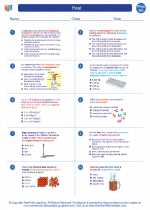Newton's Third Law of Motion
Newton's Third Law states that for every action, there is an equal and opposite reaction. This means that whenever one object exerts a force on a second object, the second object exerts an equal and opposite force on the first object.
Explanation:
To understand Newton's Third Law, it's important to remember that forces always occur in pairs. When one object exerts a force on another, the second object exerts an equal force in the opposite direction. This law applies to all types of forces, including contact forces (like a person pushing a box) as well as non-contact forces (like gravitational or magnetic forces).
Examples:
- When you sit in a chair, your body exerts a downward force on the chair, and the chair exerts an equal upward force on your body, supporting your weight.
- When a rocket engine expels hot gases downward, the gases exert a force on the rocket, propelling it upward.
- When you push a book across a table, the book exerts an equal and opposite force on your hand, causing your hand to feel the resistance of the book's surface.
Study Guide:
Here are some key points to remember when studying Newton's Third Law:
- Every action has an equal and opposite reaction.
- Forces always occur in pairs - one force does not exist without the other.
- Newton's Third Law applies to all types of forces, including contact and non-contact forces.
- Understanding this law can help explain the motion of objects and interactions between different bodies.
It's also important to practice applying this law to different scenarios and problems to gain a deeper understanding of its implications.



